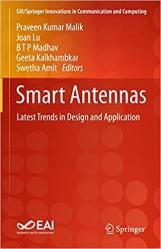 Название: Smart Antennas: Latest Trends in Design and Application
Название: Smart Antennas: Latest Trends in Design and ApplicationАвтор: Praveen Kumar Malik, Joan Lu, B.T.P. Madhav
Издательство: Springer
Год: 2022
Страниц: 421
Язык: английский
Формат: pdf (true)
Размер: 18.4 MB
This book presents the latest techniques for the design of antenna, focusing specifically on the microstrip antenna. The authors discuss antenna structure, defected ground, MIMO, and fractal design. The book provides the design of microstrip antenna in terms of latest applications and uses in areas like IoT and device-to-device communication. The book also provides the current methods and techniques used for the enhancement of the performance parameters of the microstrip antenna. Chapters enhance the knowledge and skills of students and researchers in the latest in the communications world like IoT, D2D, satellite, wearable devices etc. The authors discuss applications such as microwave imaging, medical implants, hyperthermia treatments, and wireless wellness monitoring and how a decrease in size of antenna help facilitate application potential.
Antennas are the most critical components in modern age for wireless communications. The necessity for having antennas with low profile, low weight, low cost, easy integration into arrays and microwave-integrated circuits, or polarization diversity, encouraged the researchers to develop microstrip antennas. The compatibility of microstrip antennas with integrated electronics is very evident and is a great impetus to antenna designers particularly so, now that a large variety of new substrate materials are commercially available in the market. Unlike other antennas, microstrip patch antennas can be configured with either the transmitting or receiving modes of operations. The limitations of the original microstrip antennas such as narrow bandwidth, poor polarization purity, spurious feed radiation, limited power-handling capacity, and tolerance problems have been overcome by continuous research, design developments, and performance optimizations.
This leads to the design of novel microstrip antenna configurations with accurate and versatile analytical models for the understanding of inherent limitation of microstrip antennas to satisfy increasingly stringent system requirements. The three main fundamental disadvantages of microstrip antenna are narrow bandwidth, low gain, and relatively large size. Among these three, narrow bandwidth is the most significant one and can be directly improved by increasing the substrate thickness. However, with increasing thickness of the substrate, the radiation power decreases. Different ways are proposed by the researchers to improve the bandwidth of the antenna without compromising the radiation power, including impedance matching networks using stub; novel designs; using different shapes and sizes of shots on the patch or in the ground plane such as U, step U, half step U, and L-shaped rectangular microstrip antenna; W-shaped patch antenna; M-slot folded patch antenna; microstrip antennas using magneto-dielectric substrate; complementary rhombus resonator; nanomaterial-based microstrip antenna; etc. The low-gain problem can be solved by using cavity backing, which eliminates the bidirectional radiation to provide higher gain compared to conventional microstrip antenna. The large size of the microstrip antenna particularly at lower microwave frequencies is another limitation which could be addressed by inductive or capacitive loading techniques to fabricate electrically small microstrip antenna. In some other studies, works are also reported on different composite metamaterial resonators and magneto-dielectric substrate-based microstrip antennas for size reduction.
Due to features like compact design, efficiency, high performance, lightweight, low cost, etc., microstrip patch antennas (MPA) have become common elements in modern transmit-receive systems. The microstrip antennas are often termed as microstrip patch antenna (MPA). The radiating elements and feed lines are usually photo etched on the dielectric substrate. There are many feeding methods which can be used in microstrip antennas. The traditional microstrip antennas have the impedance bandwidth of only a few percent and radiation pattern with omnidirection, which obviously does not meet the requirements of various wireless applications. To solve this problem, a variety of different design topologies have been used with different microstrip antenna element structures and different microstrip array arrangements to meet the requirements of ultra-wideband (UWB), high-gain, multi-polarized, and compact design.
Provides the latest techniques used for the design of antenna in terms of its structure, defected ground, MIMO and fractal design;
Outlines steps to resolve issues with designing antenna, including the latest design and design parameters for microstrip antenna;
Presents the design of conformal and miniaturized antenna structures for various applications.
Скачать Smart Antennas: Latest Trends in Design and Application